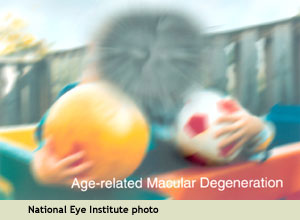
At present, there are a number of current treatments for wet age-related macular degeneration, including the drugs Lucentis, Eylea, and Avastin, administered by injection with a very small needle directly into the eye after the surface has been numbed.
There have also been a number of treatments that have proven to be inconclusive or unsuccessful after undergoing clinical trials, including stem cells, eye drops, and combination drug treatments.
Now, a research group from South Korea has reported that a gene editing technology called CRISPR-Cas9 (described below), which can locate, remove, or replace defective genes, has been delivered directly into the eyes of laboratory mice to “treat wet age-related macular degeneration efficiently and safely.”
Please note that this gene editing research is in its very earliest stages and has been conducted thus far only with laboratory mice. Nevertheless, this concept shows promise for developing gene editing treatments for a variety of retinal disorders, hereditary diseases, and cancer.
From Genome Research
This new macular degeneration gene editing research has been published online ahead of print in the February 16, 2017 edition of Genome Research, an international peer-reviewed journal focusing on research that provides insights into the genome biology of all organisms, including advances in genomic medicine.
The authors are Kyoungmi Kim, Sung Wook Park, Jin Hyoung Kim, Seung Hwan Lee, Daesik Kim, Taeyoung Koo, Kwang-eun Kim, Jeong Hun Kim, and Jin-Soo Kim, from the following South Korean institutions: the Center for Genome Engineering; Seoul National University; and Seoul National University College of Medicine.
[Editor’s note: “Genome” refers to the complete set of genes or genetic material present in a cell or an organism.]
First, An Explanation of Gene Editing
Excerpted from VisionAware’s 2016 interview with author Irv Arons about gene editing techniques for eye disease:
Put simply, gene editing is a type of genetic engineering in which DNA (a molecule that contains each person’s unique genetic code) is inserted, deleted, or replaced in a defective gene, using tiny “molecular scissors” to cut and fix the broken gene in a cell. In addition to Irv’s article on Gene Editing: The Next Frontier in Ophthalmology, a new study using gene editing applied to retinitis pigmentosa has been published online as an open-source article in the January 2016 edition of Nature: Scientific Reports.
The Nature article describes a gene-editing technology called CRISPR (or “clustered regularly interspersed short palindromic repeats”) that is used to repair a genetic mutation. In genetic science, CRISPR (pronounced “crisper”) genes are known to be essential for adaptive immunity in certain bacteria and microbes, and enable the organism to respond to, and eliminate, invading genetic material.
Maureen Duffy: Hello Mr. Arons. Thank you very much for taking the time to speak with us about gene editing. To begin, can you tell our readers what gene editing is and how it works?
Irv Arons: In gene editing, the newly discovered CRISPR/Cas9 approach repurposes the naturally-occurring defense system that bacteria use to find and disable invading viruses. In gene editing, CRISPR locates the target – which is the mutated gene – and Cas9 (or “CRISPR-associated gene,” also called “molecular scissors”) snips out the mutation. Then the two DNA ends recombine, minus the mutated (disease-causing) gene.
MD: How is gene editing different from gene therapy? Gene therapy is discussed quite frequently in relation to eye disease, but gene editing is a much newer development, correct?
Irv Arons: Yes, gene editing is only about three years old and differs from gene therapy because it locates and removes or replaces “defective” genes, while gene therapy introduces a “new copy” of a gene, without removing or replacing the existing DNA.
More about Age-Related Macular Degeneration

Age-related macular degeneration (AMD) is a gradual, progressive, painless deterioration of the macula, the small sensitive area in the center of the retina that provides clear central vision. Damage to the macula impairs the central (or “detail”) vision that helps with essential everyday activities, such as reading and writing, preparing meals, watching television, and personal self-care.
AMD is the leading cause of vision loss for people aged 60 and older in the United States. According to the American Academy of Ophthalmology, 10-15 million individuals have AMD and about 10% of people who are affected have the “wet” type of AMD.
Wet (Neovascular) Macular Degeneration
In wet macular degeneration, the choroid (a part of the eye containing blood vessels that nourish the retina) begins to sprout abnormal blood vessels that develop into a cluster under the macula, called choroidal neovascularization (neo = new; vascular = blood vessels).
The macula is the part of the retina that provides the clearest central vision. Because these new blood vessels are abnormal, they tend to break, bleed, and leak fluid under the macula, causing it to lift up and pull away from its base. This damages the fragile photoreceptor cells, which sense and receive light, resulting in a rapid and severe loss of central vision.
What Is Angiogenesis?
Angiogenesis is a term used to describe the growth of new blood vessels and plays a crucial role in the normal development of body organs and tissue. Sometimes, however, excessive and abnormal blood vessel development can occur in diseases such as cancer (tumor growth) and AMD (retinal and macular bleeding).
Substances that stop the growth of these excessive blood vessels are called anti-angiogenic (anti=against; angio=vessel; genic=development), and anti-neovascular (anti=against; neo=new; vascular=blood vessels).
The focus of current anti-angiogenic drug treatments [i.e., injections] for wet AMD is to reduce the level of a particular protein, called vascular endothelial growth factor, or VEGF, that binds to cells on the inner lining of blood vessels (vascular endothelial cells) and promotes their abnormal growth in the retina and macula; thus, these drugs are classified as anti-VEGF treatments.
About the New Gene Editing Research for Macular Degeneration
Excerpted from Genome surgery with CRISPR-Cas9 to prevent blindness, via Science Daily:
Scientists at the Center for Genome Engineering [in south Korea] report the use of CRISPR-Cas9 in performing “gene surgery” in the layer of tissue that supports the retina of living mice.
In age-related macular degeneration (AMD), vascular endothelial growth factor (VEGF) causes the formation of new blood vessels in the eyes, but also leads to leakages of blood and fluid into the eye, damaging an area at the center of the retina called the macula.
Injections of anti-VEGF drugs are the most common treatment against AMD, but at least seven injections per year are required, because VEGF is continuously over-expressed by the cells of the diseased retinal pigment epithelium. Instead of such invasive treatments, [these] scientists believe that gene therapy with the … gene editing tool CRISPR-Cas9 could improve the situation.
[Editor’s note: Retinal pigment epithelium (RPE) cells are the deepest cells of the retina. The RPE helps to maintain the health of the retinal photoreceptor cells, called rods and cones. These photoreceptor cells are triggered by light to set off a series of electrical and chemical reactions that helps the brain to interpret what the eye sees. The degeneration of the RPE cells also leads to the death of the rods and cones and, ultimately, vision.]
“The injections tackle the effects, but not the main cause of the problem. By editing the VEGF gene, we can achieve a longer-term cure,” explains Jin-Soo Kim, Director of the Center for Genome Engineering. CRISPR-Cas9 can precisely cut and correct DNA at the desired site in the genome. The CRISPR-Cas9 system works by cutting DNA at a target site, in this case, inside the VEGF gene.
In this study, the research team successfully injected CRISPR-Cas9 into the eyes of a mice model with wet AMD and locally modified the VEGF gene…. Scientists assessed the whole genome of the animals and found the CRISPR-Cas9 complex modified only the VEGF gene and did not affect other genes. The progression of the eye disease was monitored by looking at choroidal neovascularization (CNV), the creation of new blood vessels between the retina and the sclera – a common problem of ‘wet’ macular degeneration – and researchers found the CNV area reduced by 58%.
While CRISPR-Cas9 is conventionally used to correct mutations causing hereditary diseases or cancer, this study suggests a new therapy for non-hereditary degenerative disease.
VisionAware will continue to update this gene editing research as results become available.
Additional Information About Macular Degeneration
- New Macular Degeneration Research: Will My AMD Affect Both Eyes? If So, How Soon Will That Happen?
- Clinical Trial Update: Squalamine Eye Drops for Wet Macular Degeneration
- Clinical Trial Update: An Unsuccessful Trial of Combination Drugs Fovista and Lucentis for Macular Degeneration
- What Treatments are Available for Wet Macular Degeneration?